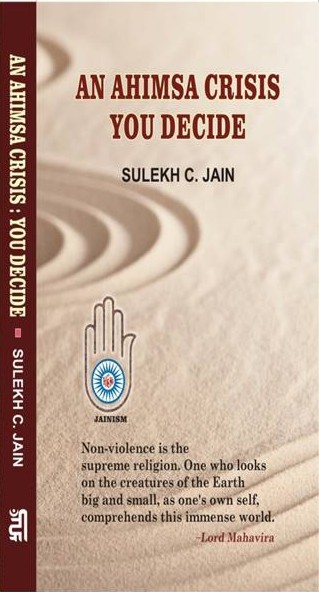The answer is yes. All wool is nothing but the hair of mostly domesticated (vegetarian) animals. Most of the wool that we use comes from sheep and goat. These animals are specially raised (like dairy farming) mainly for the purpose of wool and secondarily for meat. The major centers of wool production are New Zealand (with 60 million sheep; 20 times more than the human population of New Zealand), Kashmir, Australia, and several other places.
In the books, many of us read when we were younger, sheep live happy lives, roaming free until they are carefully sheared and dying peacefully after a long, idyllic life. For most merino and other sheep in Australia and other places, such portraits are simply fairy tales.
Every year, millions of gentle lambs endure painful mutilations in which tender skin is cut from their backsides. And when their usefulness as wool producers ends, thousands of terrified sheep are crammed onto multi-story ships to be transported for days and even weeks to countries where they will be violently slaughtered far from the paddocks where they were raised. Their painful deaths are little more than statistics for an Australian wool industry where this misery has become standard practice.
Australia is the largest producer of wool in the world, with most of it coming from merino sheep. These sensitive animals are specifically bred to have extra-wrinkly skin, which produces more wool for the industry to push onto global markets. Those wrinkles collect moisture and lead to a hideous condition called “flystrike,” in which blowflies lay eggs in the folds of the sheep’s skin and resulting maggots eat their flesh, sometimes all the way to the bone.
Rather than making sensible and humane efforts to prevent the condition, Australian farmers perform a dreadful procedure called “mulesing,” in which chunks of flesh from around lambs’ tails are cut using instruments resembling gardening shears. The mutilated lambs stumble away in pain with raw, bloody wounds.
This cruel practice is just the beginning of a lifetime of escalating pain and fear inflicted on these naturally gentle and playful animals. Once their wool production declines, many sheep are exported to the Middle East or North Africa on sweltering, multi-story ships crammed full of terrified animals who are forced to live amidst their own filth for weeks. Many die en route: some are trampled to death, and others perish slowly from illness.
When sheep or goat is ready to be sheared, this is done by automated machines these days. The sheep is tranquilized and held tightly in the shearing machine (so that it cannot move). The animal is frightened and the automatic machine does the shearing. Since the outside body of the sheep is not smooth (it is curvy and with some bones protruding) the machine severely injures the skin with major cuts, bruises and bleeding. The helpless creature suffers lots of pain and injury. Some wounds become septic and about 10 % or so sheep are so severely injured that they are killed right way. Every year this cycle goes on. When a sheep cannot produce economical quantity of wool (just like the cow which can no longer produce milk), it goes to slaughtering right way. The shearing of sheep for their wool involves an unspeakable amount of violence
Jains use and trade extensively in woolen clothing and wool items. Quite a few big mill owners of wool products (especially in Ludhiana, Punjab) are Jains. Even some Jain sadhus use woolen cloths. Use of woolen shawls (for men and women) during winter and as gift and for honoring someone is quite prevalent within the Jain community.
Some Jains defend this because it has been traditional to use wool. Prof. Gary Francione, a Jain himself, questions and says that tradition can no more suffice here than it can in any other area of human conduct. If Jainism stands for anything, it represents the notion that ethics is a matter of rational thought and careful consideration. It is precisely when we have been lulled into complacency by tradition that we must be most conscientious. HH the Dalai Lama says “traditions are never cast in concrete and hence in light of the new knowledge, facts, time and environment, traditions must be changed.”
There are some who say that we cannot live a perfect life so it is acceptable for us to eat dairy or to use other animal products as a “compromise.” Jainism certainly recognizes that we cannot avoid all violence in our lives, which is precisely why laypersons are not required to eschew violence to immobile, one-sense organisms. In the words of Prof. Francione, “but if our inability to avoid all Himsa means that we can eat dairy or use silk and wool, which involves inflicting injury and death on three to five-sensed beings, then it must mean that we can eat flesh as well.”
Francione mentions here that another principle that applies here is of the need vs. want and of minimum and necessary/ unavoidable himsa. Jains are supposed to weigh each need whether it is a need or a want and even if it is a need, how and in what way, I can minimize himsa. Certainly, since many other alternatives are available which are just as good or may be even better, one can avoid the use of milk, wool, leather and silk in daily use.
There are some who argue that because dairy products, wool, and other animal products do not necessarily involve suffering (these products can, it is claimed, be produced “humanely; the animal is not killed”); these products are different from flesh. But under the very best of circumstances, there is suffering involved in the production of these products, and the death of animals is a necessary aspect of any industry or practice that uses animals.
We have an obligation to take care of the domesticated animals we have brought into existence. But we should not continue to bring more into existence or to create a demand for animal products. To do so cannot be reconciled with the principle of Ahimsa.
Please allow me to share some sad details about what was witnessed and documented on a sheep farm in the town of Smeaton in Victoria, Australia: “
Bodies of dead and dying sheep littered the farm’s fields, some being eaten alive by maggots. One ram was found sitting alone in an apparent state of shock. He was away from his flock, too weak to move, and trembling. The ram had been “mulesed,” left with a broad chunk of flesh cut from his backside in a crude and painful attempt to stop flies from laying their eggs in the moist folds of his wrinkled skin.”
My brothers and sisters, so far I have described how sheep are treated and wool is produced in Australia and other countries but I must submit that conditions and cruelty to sheep in India is no less; in fact it is lot worse than the countries I have described above. You will be shocked to see the torture if you ever decide to take a tour and see the whole situation with your own eyes. I guarantee, just do it once and you will never use silk and wool again.
ALTERNATIVES:
Instead of shopping for heavy, itchy wool socks and mittens or expensive angoras or cashmere sweaters, choose garments made with more light –weight and colorful materials, like nylon, acrylic, orlon, polyester, fleece, cotton, flannel, synthetic, shearling, Tencel, Gore-Tex, Thermolite, Thinsulate, and Polartec Wind Pro.
As with silk and leather, in the last Eighteen years, I stopped buying or accepting any more clothing or items made of wool. However, I must admit that I do have a stock of such items that will last me my lifetime. So far, I have not decided to solve this dilemma, options would be to wear, not wear, donate, or throw them in garbage. In various meetings and gatherings in India, I did talk about wool the same way I do about the use of silk and leather. Luckily, I have been able to convince a few and don’t know how long that passion will last with them. I hope forever.
Now you decide: is this behavior consistent with ahimsa?
 Dr. Sulekh Chand Jain
Dr. Sulekh Chand Jain
